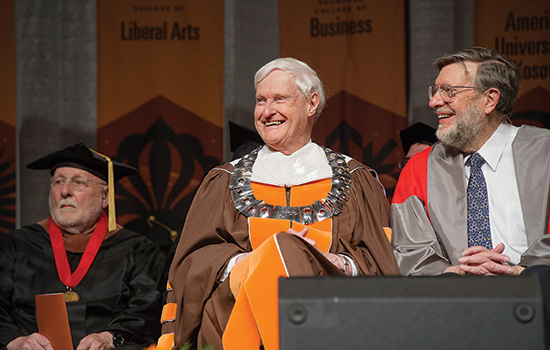A top 100 global university by 2025
A. Sue Weisler
Joshua Locke landed a job as a microelectronics-processing engineer at Texas Instruments. Hadjara Moussa, of Niger, is the recipient of the Fulbright Scholarship and a social entrepreneurship award from the U.S. Department of State. David Principe is already a principal investigator for two NASA-funded grant projects in astrophysics. Chenae Laldee is Miss Black Deaf America and is pursuing a career empowering the black deaf community worldwide.
I am in awe every year during commencement ceremonies as our graduates venture into the world with confidence and poise. RIT conferred degrees on nearly 4,000 graduates in the Class of 2014, including the impressive group noted above.
I noticed two important milestones during ceremonies this year. RIT passed Cornell and is now the second largest producer of STEM (science, technology, engineering, math) degrees among all private universities in the nation. (Brigham Young is No. 1.)
Also, a record 28 graduates earned their doctorates. A doctoral program in engineering will begin this fall, becoming RIT’s seventh Ph.D. program and joining astrophysics, color science, computing and information sciences, microsystems engineering, imaging science and sustainability.
We are witnessing a turning point in RIT’s history, and this brings me to the Strategic Plan 2025. Emerging themes are developing as we craft the plan. These include:
- RIT as a student-centric university. The student population and the careers for which we are preparing them are in constant flux. We must stay ahead of these changes.
- Diversity with a broader meaning. We must deploy our remarkable diversity, not only ethnic, racial and social, but also programmatic, intellectual and experiential as an engine of innovation and creativity.
- RIT as a national research university. RIT will soon be elevated from a “master’s university” to a research university by the Carnegie Foundation as we increase the number of Ph.D. degrees we grant. This will eventually affect some of our rankings, such as U.S. News and World Report, and provide us with new opportunities.
- Expanded global reach, identity and alumni engagement.
I would like to see RIT become recognized as one of the top 100 universities in the world within a decade. I don’t believe we can achieve the goal of being one of the finest world universities by simply copying what others are doing. To the contrary, we must develop our own distinct identity and a reputation for excellence in important emerging fields.
For example, I believe we are witnessing a merger of two distinct disciplines in which RIT holds very strong hands. These are computer gaming, and film and animation. These two fields, along with our traditional strength in imaging science, can position us to be global leaders in the huge emerging field of digital media.
I welcome your feedback. Email strategicplanning@rit.edu or go to rit.edu/president/plan2025 for more information. We are taking input through Sept. 30 with the goal of having the plan approved by the Board of Trustees in November. Help us chart the direction of RIT for the next decade. Together, let’s continue to be in awe of our university.
Cordially yours,
Bill Destler
President














